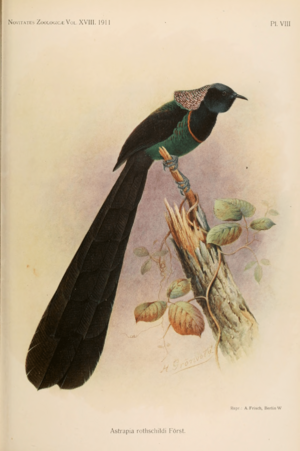Rothschild's astrapia facts for kids
Quick facts for kids Huon astrapia |
|
|---|---|
 |
|
| Illustration depicting a male A. rothschildi. | |
| Conservation status | |
| Scientific classification | |
| Genus: |
Astrapia
|
| Species: |
rothschildi
|
The Huon astrapia (Astrapia rothschildi) is a beautiful bird that lives in the forests of Papua New Guinea. It's also called Rothschild's astrapia or the Huon bird-of-paradise. This bird is part of the amazing bird-of-paradise family, known for their stunning colors. Like many birds in its group, the Huon astrapia can be quite hard to find in the wild.
Contents
What's in a Name?
The name Astrapia comes from a Greek word, Astrapaios. This word means "flash of lightning." It describes how the bird's feathers seem to flash with bright, changing colors. The second part of its scientific name, rothschildi, honors Lord Walter Rothschild. He was a famous collector who received the first sample of this bird. A German scientist named Carl Wahnes sent it to him for his private museum.
About the Huon Astrapia
This bird is not very well known. It is a medium-sized bird-of-paradise. Males can grow to about 69 centimeters (27 inches) long, including their long tails. They weigh around 205 grams. Females are smaller, about 47 centimeters (18.5 inches) long, and weigh slightly less at 200 grams.
Male Huon astrapias are very colorful. Their heads and chests are black with a shiny, velvety-blue look. They have a bright, coppery-orange band around their neck, called a gorget. The back of their neck has special feathers that look like a blue-green plate, often tipped with pinkish-violet. Their upper bodies and wings are black with a bronze-green shine. Their undersides are a deep oily green, with lime-green scale-like feathers on their sides. Their very long tail feathers are purplish-black with a blue shine.
Female Huon astrapias are not as colorful. They are mostly a dull brownish-black. Their upper parts are a lighter brown than their heads. Their tails are much shorter than the males' and are a duller brown color. It takes about 5 to 6 years for these birds to get their full adult feathers.
Sounds They Make
We don't know much about the sounds the Huon astrapia makes. Their calls are described as a rough "jj jj jj" sound. When adult males fly, their wings make a "shek" noise, like a sprinkler. This is similar to other birds in their group. Most of the time, they are quiet and shy.
Behavior and Life
We still have a lot to learn about how the Huon astrapia behaves.
What They Eat
The Huon astrapia eats different kinds of food. They are known to eat seeds from Pittosporum plants. They also enjoy fruits from Heptapleurum and Freycinetia plants. Besides plants, they also eat small animals. This includes skinks, and possibly insects and arachnids (like spiders). They often search for food by poking into holes in trees. They also peck and tear apart moss and other plants growing on trees. They spend most of their time in all parts of the forest, except the very top. However, they mostly find their food in the lower parts of the forest.
Reproduction and Nests
Huon astrapias find partners and mate in the top parts of the forest. They build nests from October to November. The female builds a strong, shallow cup-shaped nest. She uses vines, dirt, and roots, and places it on a base of large leaves and moss. The female bird does all the work of building the nest and raising the young. She lays only one egg. The egg is pinkish with fine streaks of lavender-grey. We don't know how long the egg takes to hatch. However, the baby bird stays in the nest for up to 27 days.
Bird Mix-Ups
The Huon astrapia is not known to mix with other birds-of-paradise to create hybrids. There was one report of a possible hybrid between it and the emperor bird-of-paradise. However, this is probably not true because these two birds live at different heights in the mountains.
Family Tree
The Huon astrapia is a unique species, meaning it does not have different types or subspecies. In the Astrapia bird group, it seems to be in the middle of the family tree. It is more closely related to the Ribbon-tailed astrapia and Stephanie's astrapia. It is less closely related to the Splendid astrapia and Arfak astrapia.
Where They Live
The Huon astrapia lives only on the Huon Peninsula in Papua New Guinea. They live in mountain and subalpine forests. You can find them at heights from 1,460 to 3,500 meters (about 4,800 to 11,500 feet). They often show off their beautiful feathers on ridge tops and at the edges of forests. These birds are thought to stay in one area and not move around much.
Protecting the Huon Astrapia
The Huon astrapia is listed as a Least Concern species. This means it is not currently in danger of disappearing. However, because we don't know much about it, it almost falls into the Data-Deficient category. This means we need more information to be sure. It is listed in Appendix II of CITES. This means that trading these birds or their parts is controlled. People do not usually hunt this bird. However, the skins and long tail feathers of the males are important cultural items for the people of Nokopo.


